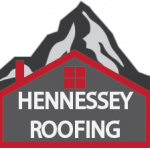
Your roof is one of the most important aspects of your home. It’s the shield your family uses to brave all the weather nature throws at you. That makes it incredibly important to stay in working condition. That’s why Hennessey Roofing has put together this list of the signs of damage on shingle roofing. Using this list, you can make sure your roof doesn’t have any damage. If your roof does have damage, you may want to get a roof inspection from a local roofer. If the damage is found early enough, you may be able to repair it instead of having to replace your whole roof.
Wind Damage
Strong winds aren’t uncommon for Colorado, especially since nearly every storm brings them. Wind damage is one of the most significant components of storm damage to a roof. High-speed winds can tear up your roofing and sometimes tear shingles right off your roof! Even if the wind only partially pulls up a shingle, it can be disastrous. When the shingles are in position, they protect your roof’s internals. When one starts flapping in the wind, it leaves your sensitive roofing in a vulnerable state. Signs of wind damage are creases on your shingles where the wind bent them, as well as granules around the edges of your roof where the wind has blown off layers of the shingles.
Hail Damage
Hail is notoriously bad for shingles. The impacts from hail can be brutal, and after a hail storm, getting a roof inspection is recommended as soon as possible is recommended. Hail can knock shingle granules off, just like the wind. However, hail can do even more severe damage. The impacts can rip and even tear shingles! Seeing shingles, or bits of shingles, in your yard is a sure sign that your roof has shingle damage.
Water Damage
Once your shingles have taken damage, they can get worse. Without the protection of shingles, water can leak into the vulnerable inner roofing. The first thing that causes leaks. However, it still gets worse. If it isn’t fixed, the water damage will get extreme. It can go from a little leak to a large leak to a section of roofing caving in. That’s why it’s essential to ensure that your roofing isn’t damaged!































